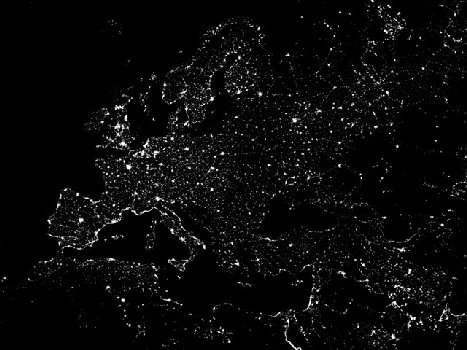| Climate Change |
| One of the biggest challenges facing mankind
is the build-up of carbon dioxide in the atmosphere as a result of the
burning of fossil fuels - coal, oil and natural gas. Carbon dioxide is
one of the "greenhouse gases" which keeps our atmosphere warm by trapping
light from the sun as heat.
A night-time satellite view of Europe shows areas of high energy use - cities, industrial centres and transport routes. When fossil fuels are burned, carbon is released from the Earth's rocks into the atmosphere in the form of carbon dioxide. Although there are mechanisms for the excess carbon dioxide to be absorbed in the oceans or the biosphere as part of the natural carbon cycle, measurements over the last century indicate that the gas is accumulating in the atmosphere - an extra 30% since the middle of the nineteenth century. The release of carbon dioxide seems to be too fast for the natural carbon cycle to absorb. In the short-term, a rise in average temperatures is likely - global warming. It is reckoned that global average temperature rose by 1°C over the twentieth century, with eight of the ten warmest years on record occurring in the 1980s and 1990s. Temperature increases, however, are not evenly spread: climate models predict that any warming will be concentrated near the polar regions. The observed thinning of Arctic sea ice, and the discovery of a broad stretch of open water at the North Pole in the summer of 2000, may be among the first conclusive signs that global warming is happening. Declassified submarine records show Arctic sea ice is 40% thinner than it was 40 years ago and satellite images show the area covered is shrinking by 4% per year. By 2050 there may be no ice left at the north pole in summer. In the longer term, a warmer planet would lead to increased evaporation from the oceans, and more clouds might reflect more heat away, tending to stabilise the temperature. On the other hand, if sea ice melts and the Antarctic ice shelves shrink, less heat would be reflected and the warming could accelerate. In any event, changes to climate patterns are expected. Extreme weather events could become more common; vegetation zones could shift, with the American grain belt likely to move north; coastal areas would be liable to flooding as sea level rises due to thermal expansion of ocean water; some climate models predict that the Gulf Stream in the North Atlantic would weaken or even fail, having a major impact on the climate of western Europe.
Wind farms, such as this one in northern Spain, are one of a number of "clean" alternatives to fossil fuel for generating electricity. The leading industrial nations have agreed to reduce their output of carbon dioxide, but most are struggling to meet their targets. Increasing prosperity is increasing energy consumption at a faster rate than energy-efficiency measures are reducing it. Non-greenhouse alternatives to fossil fuels such as wind, solar and wave power are being developed only very slowly. Nuclear power is in decline due to safety concerns. With its ease of transport and storage, petroleum remains an attractive fuel for private and commercial motor vehicles. |

